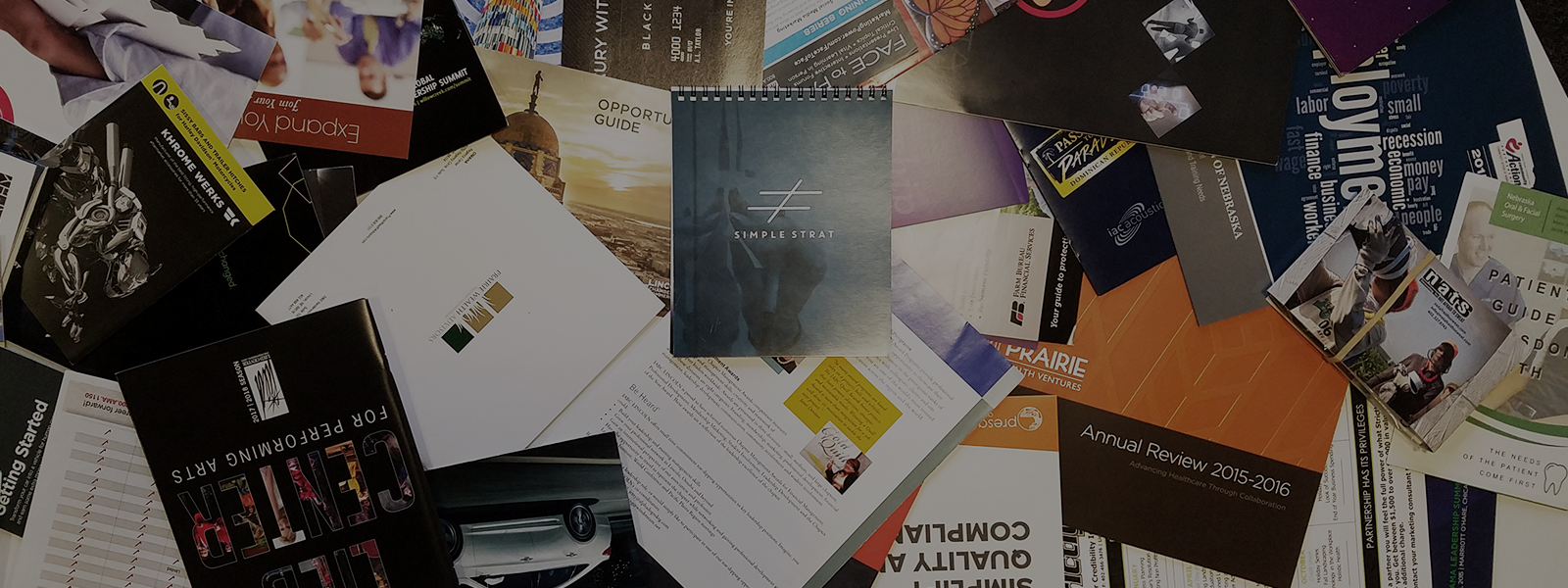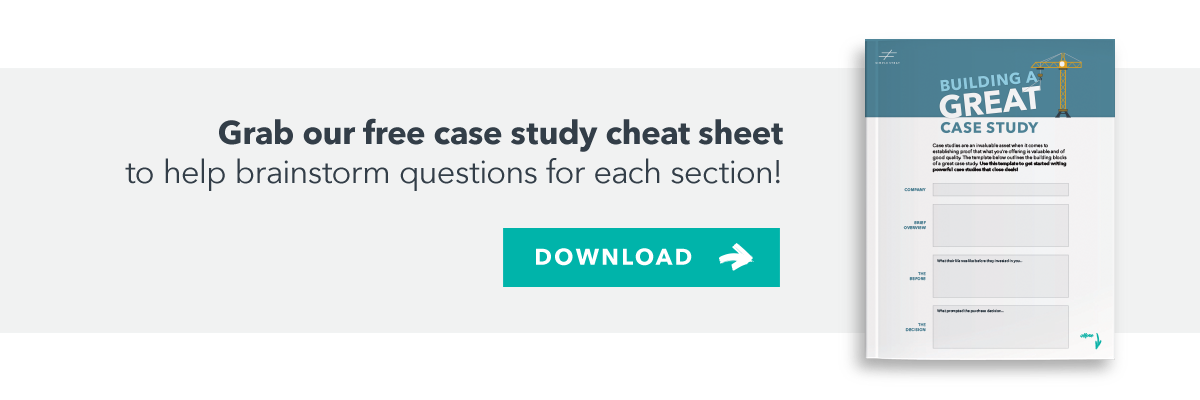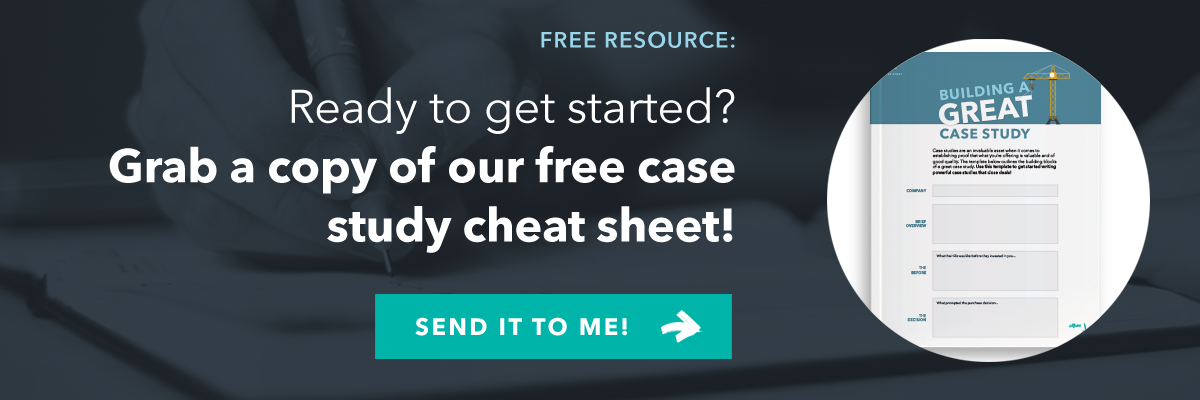How to Write a Case Study That Helps You Close More Deals
December 15, 2017

Ali Schwanke

Case studies are a great way to gain trust from potential clients by providing a real-life example that demonstrate your company’s capabilities.
It’s easy to say you're the best when it comes to providing X, or that you are a thought leader in industry Y.
But potential customers want proof.

Many companies know they should use case studies in their marketing funnel – particularly at the “consideration” or “decision” stages. However, writing a case study takes more than just asking a client to talk about what it’s like to work with your company.
Your case study needs to paint a picture of the problem that existed before, the way in which you solved that problem, and how you’ve changed the lives of your customers for the better.
In this article, we’ll help you learn how to write a case study by tackling questions such as:
- What clients should you feature in your case studies?
- What types of information should be included in each case study?
- What are some case study interview questions you should use?
- How long should my case study be?
- How should I use my case study to close more deals?
Step 1: Choosing which client to feature in your case study
A great story is the foundation of a powerful case study – and every story features a few main characters (as well as a perilous journey, a climax and a resolution!).
Here are a few things to look for when determining which clients you should feature in your case studies:
Documented Success
This one may seem obvious, but you must choose a client who has experienced great success in working with your company. Besides telling a great before and after story, clients who have experienced success are more likely to participate in the process and share the message with their audience as well.
Full Suite of Services
Not every client utilizes all that your company has to offer. When it comes to writing a case study, if possible, try to focus on the clients who utilize more than one service. This helps showcase your company's capabilities in response to the customer’s problem.
Appropriate Size/Representation
Using a big-name client helps establish trust in your business from square one. In the same way, featuring a client who has a smaller-sized company may allow you to link your success more intimately to the results of the overall company. In writing the case study, keep in mind that larger companies typically have many layers of approval, which may extend the timeline of your case study development. Smaller companies are usually quicker to gather results and approve information.
Relatable
Know your target audience, and choose a client that they can relate to. You may consider choosing clients all within one industry to launch case studies specific to that customer segment. This also goes for geographic region, clients who all had specific types of problems, or a group of clients who all experienced a particular result relative to a product or service that you sell.
Step 2: Gather background information
When you’re writing a case study, you should have a high-level understanding of the client’s success. Perhaps the sales team mentioned in your last sales meeting that client XYZ is a great candidate for a case study; or the customer service team put out a request for you to follow up on. This information is vital.

Before you dive into the interview, you’ll want to talk with the person or team who worked directly with the client. This will allow you to gain some background information that will help you shape the overall flow of the case study, as well as the questions you need to ask.
Keep in mind that you’ll also need to explain the background of the company in your case study, so tracking down an “about us” paragraph for the client or asking for a short company description will be important.
Step 3: Write your case study interview questions
Even if you have the perfect client, nothing derails a great case study faster than a poor interview about their experience. You need to have good questions that you can ask the client about their experience and results!
Here are a few tips for writing great case study interview questions:
- Stick to open-ended questions or questions that can’t be answered with a simple ‘yes/no’. Give your client the opportunity to share all aspects of their experience working with your company.
- Keep your questions success oriented. Each question should set up the answer to demonstrate how your client benefited and show that your services were instrumental to that success.
- Tailor your questions towards your target audience. If you know your audience’s challenges and doubts, you can customize questions to provide answers that directly relate to those feelings.
Another tip is to think about when developing case study interview questions is – write and categorize your questions by topic or area.
Common categories may include:
- Client's business
- Company challenges
- The decision on who to go to for help (why they chose you over a competitor)
- Solutions in action
- Results
Sticking to these categories will make it easier to get unique answers.
If you’re looking for a handful of questions to get started, we’ve got you covered.
Here are some examples of case study interview questions that we’ve used in building our own case studies or case studies for clients:
- What was the main reason why you decided to work with Company XYZ?
- Why did they decide to pursue a solution to their problem? Was there something that triggered their decision?
- Who else did they consider working with? Why did they ultimately decide your company was best suited to help?
- How did Company XYZ go about solving that problem?
- How was the problem impacting your company in a tangible way? What were the signs and symptoms of the problem you were trying to solve?
- What were the results of working with Company XYZ? How did you measure the impact of this?
Step 4: Conduct the case study interview
Hosting a successful case study interview, whether on the phone or in person, requires excellent communication and organization.

Clients are often happy to give their time, but they are not as cooperative when the process is scattered or they’re left feeling unprepared.
Here are a few tips for a successful case study interview:
- Send the interview questions in advance. Let them know that the questions are a guideline for the conversation.
- Communicate your process. Clients often want to know if they will be able to review the case study prior to finalizing it. Some clients have internal standards that prevent their logo from being used to promote results for another company. In this case, you’ll have to lead with a description of the company in industry XYZ.
- Let them know how you plan on conducting the interview. If it’s a phone interview, encourage them to be in a quiet place with a solid phone connection so you can make the most of your time together. If it’s a video interview, let them know beforehand as they may or may not have video conferencing capabilities. If you’re planning on recording the interview, this too needs to be communicated in advance.
By sharing and managing expectations, you’ll earn trust which will translate to a great conversation about their experience.
Step 5: Review the interview and identify building blocks of the case study
While each case study is specific to the customer you’re featuring, for consistency of your brand and ease of development of future case studies, it should follow a similar flow.
Below is an example of a layout you can follow when writing your case study.
- Compelling title/headine
- Summary
- Challenges
- How you helped
- Results
- About
Review the interview you had with the client as well as the background information provided by the sales team or other contacts within the company.
Identify common themes relative to the problem-solution scenario and outline the rough draft of your story.
In addition to this, you’ll want to pull out specific statistics and results that can be used to highlight significant information. This may include numbers relative to sales, cost or time savings, employee morale, new innovations, days without errors, etc.

When designing the case study, consider making this type of information into a chart or infographic to increase visual appeal and grab readers’ attention.
Step 6: Write the case study
Whether you use our case study template, or you have one of your own, at this stage you’re putting all of the information together. With the building blocks identified though, don’t forget about the storytelling aspect of the content.
As important as statistics are, people are attracted to stories.
When writing your case study, dive deep into the client - their struggles, their needs, where they want their company to be. As humans, our purchasing behavior is driven by emotion and supported by logic – so both elements need to be present in your case study.
Step 7: Review for maximum impact
For one final step, you’ll want to have others review your case study – this might be the sales team, customer service team, executive staff, etc. Make sure it’s free of errors. It also needs to be clear and compelling – potential customers should understand that you can solve that specific problem, and solve it at the highest degree!
When finalizing the information, you’ll want to have it a few forms.
- PDF available for download (make sure the file size is small enough so that it’s not utilizing a ton of bandwidth when the user clicks to download or view)
- Hard copy for sales meetings (this could be printed from pdf, but make sure that your bleeds/margins are set appropriately so it still looks professional when printed in office)
- Webpage or landing page
- Video – you may choose to take the written content and turn it into a quick video as well!
Step 8: Put the case study to work to close more sales
There are a number of ways to use case studies to market your company. However, keep in mind that a case study is a marketing tool at the consideration or decision stage of the buyer’s journey.
At this stage, buyers are already aware of their problem and they’ve decided they’re going to try to solve it. A case study delivered too early in the process could hamper your ability to get results due to improper timing.
So when should you use a case study? Consider the following case study marketing examples:
- Sales meeting follow-up. The sales team member just had a meeting with a potential customer. In this meeting the customer talked about how they had problem XYZ and were just frustrated by trying to solve it. You talked about how you solved this for another company and they were happy with the results. This is a perfect opportunity to share the case study in that meeting, or follow up with marketing automation through email following the meeting.
- Presentations. Weaving a case study into your presentation is a great way to showcase your ability to deliver results while telling the story of a client and their journey.
- Email campaigns to prospects. Add the case study as a piece of content in your next email campaign.
- Social media. Feature a monthly case study on your social media or promote the content through LinkedIn sponsored content.
If you need some help writing the case study or building out your case study library, we can help as well. Simply request a consultation.
Conclusion:
Case studies are powerful pieces of marketing collateral. They help you showcase how your company solves specific problems for your customers. Not only does it establish trust in the mind of a potential buyer, but it highlights your ability to deliver results.
Do you have a case study you’re proud of? Or questions about writing one? Comment below!

Ali Schwanke
Ali Schwanke is the CEO and co-founder of Simple Strat, a HubSpot Solutions Partner. She’s a top contributor for Martech.org, a frequently sought out podcast guest, and host of her own show Marketing Deconstructed, where she shares insights on B2B content strategy and marketing. She’s also the founder and co-host of HubSpot Hacks, and is an advisor for professional education partners like Thinkific and Vistage.
Relevant Blog Posts

Top 26 HubSpot Hacks for Marketing Pros
If you've invested in HubSpot Marketing Hub, you know the promise: powerful growth, streamlined processes, a happy team. But let's be real – there's a TON of info out there on HubSpot. Sorting...

Marketing Collateral: The Ultimate Guide (With Examples)
When we’re talking about marketing, things can get kind of buzz-wordy. Marketing collateral. Landing pages. Audience personas. Ever feel like you need a guide to walk you through these things?...

Using Content for Top-of-Funnel Marketing (Plus Examples)
What does your content have to say? Does it answer your audience’s most burning questions? Does it bring them value after they read, watch, or listen to it? Delivering value via content is especially...

